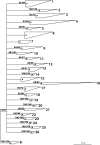Acidobacteria phylum sequences in uranium-contaminated subsurface sediments greatly expand the known diversity within the phylum
- PMID: 17337544
- PMCID: PMC1892891
- DOI: 10.1128/AEM.02012-06
Acidobacteria phylum sequences in uranium-contaminated subsurface sediments greatly expand the known diversity within the phylum
Abstract
The abundance and composition of bacteria of the phylum Acidobacteria were surveyed in subsurface sediments from uranium-contaminated sites using amplification of 16S rRNA genes followed by clone/sequence analysis. Analysis of sequences from this study and public databases produced a revised and greatly expanded phylogeny of the Acidobacteria phylum consisting of 26 subgroups.
Figures

References
-
- Anderson, R. T., H. A. Vrionis, I. Ortiz-Bernad, C. T. Resch, P. E. Long, R. Dayvault, K. Karp, S. Marutzky, D. R. Metzler, A. Peacock, D. C. White, M. Lowe, and D. R. Lovley. 2003. Stimulating the in situ activity of Geobacter species to remove uranium from the groundwater of a uranium-contaminated aquifer. Appl. Environ. Microbiol. 69:5884-5891. - PMC - PubMed
-
- Cain, E. C., S. M. Barns, L. Sommerville, and C. R. Kuske. 2006. Acidobacteria phylum sequences in uranium contaminated subsurface sediments. Los Alamos National Laboratory unclassified report #06-5555. U.S. Department of Energy, Washington, DC.
-
- Fields, M. W., T. Yan, S. Rhee, S. L. Carroll, P. M. Jardine, D. B. Watson, C. S. Criddle, and J. Zhou. 2005. Impacts on microbial communities and cultivable isolates from groundwater contaminated with high levels of nitric acid-uranium waste. FEMS Microbiol. Ecol. 53:417-428. - PubMed
Publication types
MeSH terms
Substances
Associated data
- Actions
- Actions
LinkOut - more resources
Full Text Sources
Molecular Biology Databases

